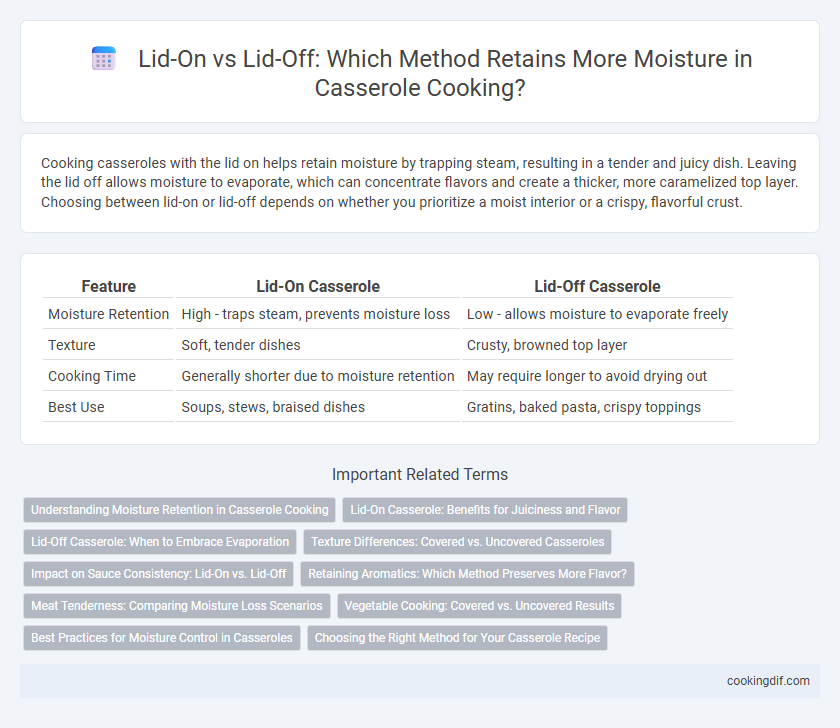Cooking casseroles with the lid on helps retain moisture by trapping steam, resulting in a tender and juicy dish. Leaving the lid off allows moisture to evaporate, which can concentrate flavors and create a thicker, more caramelized top layer. Choosing between lid-on or lid-off depends on whether you prioritize a moist interior or a crispy, flavorful crust.
Table of Comparison
| Feature | Lid-On Casserole | Lid-Off Casserole |
|---|---|---|
| Moisture Retention | High - traps steam, prevents moisture loss | Low - allows moisture to evaporate freely |
| Texture | Soft, tender dishes | Crusty, browned top layer |
| Cooking Time | Generally shorter due to moisture retention | May require longer to avoid drying out |
| Best Use | Soups, stews, braised dishes | Gratins, baked pasta, crispy toppings |
Understanding Moisture Retention in Casserole Cooking
Cooking casseroles with the lid on traps steam and moisture inside, preventing evaporation and ensuring the dish remains moist and tender throughout the cooking process. Leaving the lid off allows moisture to escape, which can result in a drier casserole with a more concentrated flavor and a crispier top. Understanding the balance between lid-on and lid-off cooking is essential for achieving the desired texture and moisture level in casseroles.
Lid-On Casserole: Benefits for Juiciness and Flavor
Keeping the lid on a casserole during cooking traps steam, preserving moisture and preventing the dish from drying out. This method enhances juiciness by creating a humid environment that allows flavors to meld and intensify. As a result, lid-on casseroles maintain tender textures and richer, more concentrated flavors.
Lid-Off Casserole: When to Embrace Evaporation
Lid-off casseroles promote evaporation, which helps thicken sauces and intensify flavors by reducing excess moisture during cooking. This method is ideal for dishes that require a crispy or browned top layer, such as gratins or baked pasta. Embracing lid-off cooking enhances texture but requires monitoring to prevent drying out the casserole.
Texture Differences: Covered vs. Uncovered Casseroles
Covered casseroles retain moisture, resulting in a tender, juicy texture as steam circulates within the dish. Uncovered casseroles allow moisture to evaporate, producing a drier, crispier surface with intensified caramelization. Choosing lid-on or lid-off cooking directly affects texture by balancing moisture retention against crust formation.
Impact on Sauce Consistency: Lid-On vs. Lid-Off
Cooking casseroles with the lid on preserves moisture by trapping steam, resulting in a thicker, more cohesive sauce as the liquid condenses and reincorporates. Leaving the lid off allows moisture to evaporate, concentrating flavors but often causing the sauce to thicken unevenly or dry out. For consistent sauce texture and enhanced creaminess, maintaining a lid during baking is preferred.
Retaining Aromatics: Which Method Preserves More Flavor?
Covering a casserole with a lid during baking traps steam and moisture, effectively retaining aromatics like herbs and spices for a more intense, flavorful dish. Baking lid-off allows moisture to escape, concentrating flavors but potentially drying out the casserole and diminishing the aroma retention. For optimal flavor preservation, using a lid maintains the balance of moisture and aromatic compounds, enhancing the overall taste experience.
Meat Tenderness: Comparing Moisture Loss Scenarios
Cooking casseroles with the lid on significantly reduces moisture loss, resulting in juicier, more tender meat by trapping steam and preventing evaporation. Leaving the lid off increases moisture evaporation, potentially drying out the meat and leading to tougher textures. Studies show that lid-on cooking preserves up to 30% more internal moisture, directly enhancing meat tenderness and overall dish succulence.
Vegetable Cooking: Covered vs. Uncovered Results
Cooking vegetables in a casserole with the lid on retains significantly more moisture, preserving texture and nutrients by trapping steam. Leaving the casserole uncovered causes evaporation, resulting in drier, more concentrated flavors but increased risk of overcooking. Optimal moisture retention and even cooking occur when the lid remains on during the simmering process.
Best Practices for Moisture Control in Casseroles
Covering casseroles with a lid during baking significantly enhances moisture retention by trapping steam and preventing evaporation, resulting in tender, juicy dishes. For recipes requiring a crispy or browned top, removing the lid during the last 10-15 minutes allows moisture to escape while achieving desired texture without drying out the interior. Optimal moisture control in casseroles involves a strategic lid-on approach during most of the cooking time, balanced with lid-off finishing for texture.
Choosing the Right Method for Your Casserole Recipe
Choosing the right method for your casserole recipe depends on the desired moisture level and texture; cooking with the lid on traps steam and retains moisture, resulting in a tender, juicy dish. Conversely, cooking with the lid off allows moisture to evaporate, creating a thicker, more concentrated flavor and a slightly crispy top. For casseroles with delicate ingredients or sauces, a covered bake preserves moisture, while an uncovered bake suits recipes needing a golden, textured crust.
Lid-on vs lid-off for casserole moisture retention Infographic

 cookingdif.com
cookingdif.com